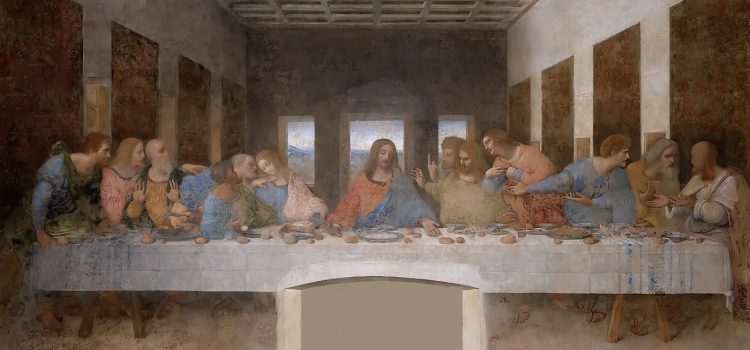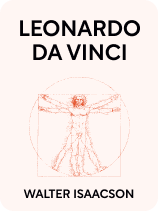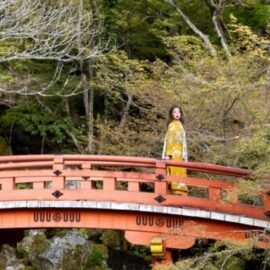

This article is an excerpt from the Shortform book guide to "Leonardo da Vinci" by Walter Isaacson. Shortform has the world's best summaries and analyses of books you should be reading.
Like this article? Sign up for a free trial here.
What is Leonardo da Vinci’s “The Last Supper” artwork about? What is the history behind the piece?
“The Last Supper” mural by Leonardo da Vinci took three years to paint, but its precision to detail and artistry made the years worth it. The painting is also iconic for its narrative that depicts Jesus’s prediction that one of his apostles will betray him.
Read below for a history of “The Last Supper” artwork by Leonardo da Vinci, as read in Walter Isaacson’s biography of the artist.
“The Last Supper”
Between 1495 and 1498, Leonardo painted “The Last Supper” artwork for Duke Ludovico—a commission that tested the duke’s patience but showcased Leonardo’s masterful application of narrative, symbology, and optics. Isaacson reports that the duke was setting up his family’s mausoleum in the Santa Maria delle Grazie monastery and he asked Leonardo to paint one of the walls of the monastery’s dining room. (Shortform note: You can see “The Last Supper” here in high definition.)
Leonardo’s creation process was haphazard, which made the monastery’s prior (or leader) and the duke uneasy. Isaacson explains that, some days, Leonardo would spend hours painting, not stopping to eat, and people would even gather around him to watch him work. On other days, he would spend hours simply looking at his work in progress, or arrive, paint a single stroke, and leave. The prior complained about his erratic progress to the duke, and Leonardo explained that working slowly allowed him to perfect his ideas. He also warned that he would use the monastery’s prior as a model for Judas Iscariot if the man didn’t stop badgering him.
(Shortform note: Besides being placed at the Sforza family’s mausoleum, the painting included other “Easter eggs” that referenced Ludovico and his court. For example, Leonardo had members of the Milanese court model the different characters in the painting, and the tapestries in the painting were reminiscent of the tapestries in Ludovico’s castle.)
The duke’s patience ran thin when his wife died. She was placed in the mausoleum, so he went to the monastery and ate dinner there every week. Isaacson says that to speed Leonardo up, Ludovico had him sign a contract clearly stipulating the deadline. But the duke’s patience was finally rewarded with a work of art that encapsulates much of Leonardo’s genius through three key characteristics that Isaacson identifies. (Shortform note: Besides rewarding the duke’s patience, the painting also catapulted Leonardo to the widespread recognition he craved.)
The Narrative
Isaacson explains that the painting shows the aftermath of Jesus declaring that one of his apostles would betray him that night. Leonardo lifted each apostle’s emotions and reactions from the Bible and painted gestures and expressions that would showcase them. (Shortform note: There’s been a lot of speculation about the gestures the apostles make in the painting and whether they convey a secret message from Leonardo. However, it’s most likely that they just convey the drama of the situation through gestures that would have been commonly understood at that time.)
The Symbology
Jesus’s gestures are symbolic of the Eucharist (a Christian rite of thanksgiving and commemoration of the Last Supper). Isaacson explains that Christ’s hands are signaling toward a glass of wine (symbolizing his blood) and a piece of bread (his body). After declaring that one of his followers would betray him, the Bible describes how he blessed the wine and bread and shared it with the apostles because his blood would cleanse their sins. Leonardo chose the placement of Jesus’s hands carefully: The first thing you see is the hand pointing toward the piece of bread and inviting you to participate in the Eucharist.
(Shortform: Although he was mindful of tradition, Leonardo might not have bought into the religious meaning of the painting. Critics speculate that Jesus doesn’t have a halo because Leonardo thought Jesus was a regular person.)
The Application of Optics
Isaacson argues that Leonardo applied his knowledge of optics to “The Last Supper” artwork in two ways:
1) He made Jesus larger than the other characters. He painted him in front of an open window, knowing that a light background makes objects appear larger. This way, he achieved the dominant effect he desired without making Jesus seem unnatural compared to the other characters.
2) He deftly applied the laws of natural and artificial perspective—and disregarded them when necessary. All the straight lines in the painting meet at a vanishing point on Jesus’s forehead. This helped Leonardo create a natural perspective and make the painted room seem real—like an extension of the actual dining room, with even the tapestries in the painting aligning with the tapestries in the monastery room. To achieve this effect, he stuck a nail in the center of the wall and carved radiating lines on the wall to guide his paintbrush.
However, natural perspective has its limitations, which Isaacson says Leonardo got around by playing with artificial perspective. The wall is too large and the room too narrow for a viewer to stand at the perfect distance from the painting to take the scene in without it looking distorted. Artificial perspective made it possible to adjust how viewers would see the painting, depending on where they were in the room. Isaacson identifies a series of optical illusions Leonardo applied to make the viewing experience smooth, such as:
- Aligning the painting perfectly with the left wall, but not the right wall
- Making the right side of the painting’s ceiling slightly higher than the left
- Making the right side of the painting brighter to match the light in the real room
- Making the back wall narrower and the room shorter than they would have been
- Painting the table and decorative molding across the top of the scene to disguise the ways he had interfered with the natural perspective
(Shortform note: Leonardo’s mathematical accuracy in the creation of this painting’s perspective also serves a symbolic function. Since all the lines converge on Christ’s forehead, he is the vanishing point where all the traces begin and end.)

———End of Preview———
Like what you just read? Read the rest of the world's best book summary and analysis of Walter Isaacson's "Leonardo da Vinci" at Shortform.
Here's what you'll find in our full Leonardo da Vinci summary:
- A detailed look into the life, accomplishments, and struggles of Leonardo da Vinci
- Lessons from his life and work that you can apply to your own life
- What set Leonardo apart from other artists at the time






